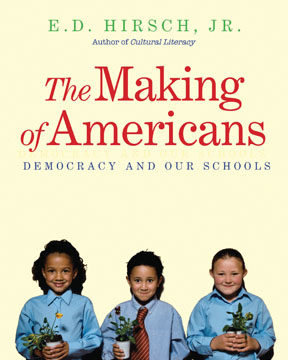 Making the Grade: The Economic Evolution of American School Districts
Making the Grade: The Economic Evolution of American School Districts
by William A. Fischel
University of Chicago Press, 2009, $55; 304 pages.
How did American schools come to be structured as they are, with age-graded schools in relatively autonomous school districts and school calendars that begin in August and end in June? Look in the mirror, suggests William A. Fischel in his highly readable new book, Making the Grade. Schools evolved into the current system because we—homeowners nationwide—wanted it that way. As Fischel puts it, “local voters, not state authorities, are responsible for the creation of the system. Educational leaders such as Horace Mann headed parades that proceeded on routes selected by the marchers, not the grand marshal.”
Fischel’s approach differs from most histories of the American school system. In other accounts, the school system developed in response to elite preferences about how it should be structured. In those tellings, the grand marshal led the parade. Pronouncements from a series of blue-ribbon commission reports and hard-charging education leaders swayed legislators to reshape schools.
True enough, concedes Fischel, but why did people accept those particular changes while rejecting a host of recommendations from blue-ribbon commissions that we have long since forgotten? The conventional “top-down” history of American education is at best incomplete. Instead, Fischel offers a “bottom-up” history that, with a few parsimonious concepts, explains quite a lot about the development of the American school system.
Two such concepts carry most of the burden. School systems have been structured to enhance homeowner property values while facilitating the build-up of place-based social capital. The first goal, enhancing property values, explains the evolution of the school system. The second, building place-based social capital, explains the system’s abiding resistance to reformers trying to change it. Fischel’s account is much more persuasive on the former than the latter.
How the drive to enhance property values shaped the development of schools is relatively straightforward and compelling. The Northwest Ordinance of 1784 and 1787 and the Land Act of 1785 set aside a portion of land in each township as an endowment for local schools. Like any modern property developer, the federal government understood that quality schools would help attract buyers and raise prices for the land it was trying to sell.
Given an agrarian society with poor transportation, schools could only draw enough students to populate one-room schoolhouses. With few students of the same age and with child labor on farms causing irregular attendance, the efficient arrangement was to group students by ability rather than age. But as transportation improved and demand for a high-school education increased, the one-room schoolhouse organized into “recitation groups” no longer sufficed. School districts consolidated, creating enrollment areas large enough to support a high school. And schools enrolled enough pupils to form age-based grades, which could offer focused instruction in specific subjects and prepare students for high school.
These changes occurred, Fischel argues, not just because education luminaries recommended them, but because homeowners understood that modern schools would enhance property values. Schools became remarkably standardized, adopting a similar calendar and covering similar material in each grade so that new residents could move into an area with relatively little disruption to their children’s education. As with the adoption of the Microsoft operating system or VHS, communities accepted these near-universal standards and structures with no central authority imposing them. Local homeowners everywhere understood that they had to incorporate these changes to compete with other communities for new residents.
Schools are designed the way they are, Fischel suggests, because we want them that way. And they continue to be that way, despite the efforts of reformers, because people generally prefer the existing system. As he puts it, “Nobody loves local public schools but the people.”
What they love, in particular, is the place-based social capital that school districts provide. Because schools enroll children according to where they live, they become a natural vehicle for people getting to know their neighbors. And knowing more neighbors enhances people’s ability to work on issues of common concern with regard to municipal government. If students had access to vouchers, then more students would go to school in other neighborhoods and even other cities. We would not know as many of our neighbors and so would be less able to join forces to get the city to put in speed bumps or clean up the local park.
As proof of general resistance to school choice, Fischel references failed voucher ballot initiatives in California and Michigan. Leaving aside whether ballot initiatives are the best measure of popular support, Fischel has to explain the growing popularity of charter schools. He attempts to square that circle by claiming that “most administrative rules give preference to students who reside in the local district” for admission to charter schools, while vouchers generally lack place-based restrictions. Fischel goes so far as to say this distinction in residential restrictions between charters and vouchers is “critical” to the greater success of charters. “If charter schools were in practice open to all comers, the ability of a locale to benefit from their success would be limited, and so would local support for charter schools.”
Unfortunately, the facts do not fit Fischel’s story. Other than conversion charters and charter schools in a limited number of states, the bulk of charter schools place no residential requirements on admission. In California, for example, which has the most charter schools of any state, the law stipulates that “admission to a charter school shall not be determined according to the place of residence of the pupil…” In Texas, another important charter state, the law prohibits “discrimination in admission policy on the basis of…the district the child would otherwise attend….” Conversely, many voucher programs, including those in Milwaukee, Cleveland, and Washington, D.C., offer vouchers only to residents of those districts to attend private schools within the district boundaries. Many proposed but unsuccessful voucher programs had similar geographic constraints.
If residential restrictions do not distinguish charters from vouchers, then something other than place-based social capital has to explain the greater relative success of charters. The obvious alternative explanation is that teachers unions are more threatened by vouchers than by charters, and their organized political power, not widespread preferences, has thwarted vouchers and stymies even charters.
But Fischel seems determined to avoid this sort of political or top-down explanation, so determined that he twists himself into an inaccurate explanation to preserve his bottom-up theory. The book would be much more compelling throughout if he offered his bottom-up theory for the development of school structures but conceded that, once created, those structures engender organized interest groups that make the structures inflexible to changing needs and potentially better ideas. Perhaps we have met the enemy and this time he isn’t us: he’s the teachers unions.
Jay P. Greene is professor of education reform at the University of Arkansas and a senior fellow at the Manhattan Institute.




